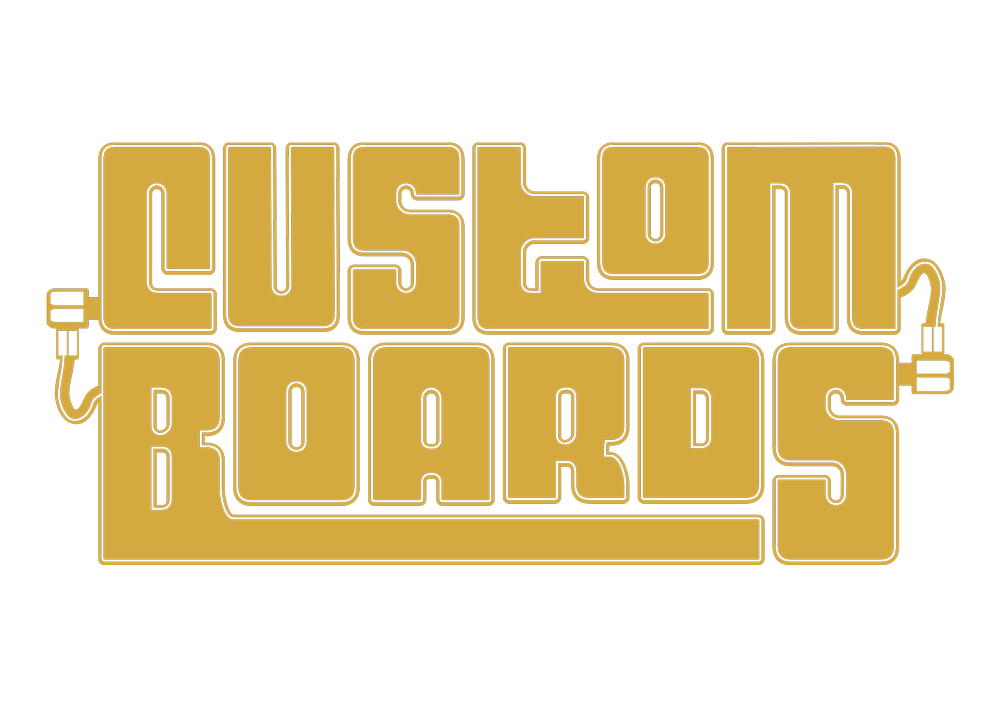Assembling AC-connectors
AC-connectors use crimping ferrules for connecting the cables to the contacts. These ferrules are squeezed tight with a pair of Custom Boards Crimping Tool.
The pliers come with an assortment of different ferrules, which will last you through this pedalboard project.

The AC-connectors used to power pedalboards:
– The AC power cable plugs into a wall outlet with a regular Schuko-plug (CEE 7/7).

– The power cable connects to the pedalboard’s power supply unit with either a regular IEC-plug (IEC C13, Voodoo Lab and T-Rex).

– Or a cloverleaf IEC C5 connector (Cioks). This connector is not sold separately. If you use a Cioks power supply, you can use a cable with a cloverleaf connector.

– The third option is IEC C7, also known as figure-8 or shotgun connector, which, too, is not available as a replacement part. If you are using T-Rex FuelTank Junior or Voodoo Lab Pedal Power X4 power supplies in your pedalboard you can order a longer ungrounded AC-cable for your cable snake.

At Custom Boards we use a wire stripping tool for AC cords.
This is due to the thicker gauges and different insulation materials used in power cables.

It is advisable to proceed slowly, and deal with each end of your power cord separately to avoid any mess-ups. Check that the backline-facing end of your snake will get the Schuko-plug, while the board-facing side gets the IEC-plug.
The power cable contains three colour-coded conductors.
- The yellow/green conductor (⏚=ground/earth) goes in the middle terminal when looking from above.
- The brown goes to the left (L=live).
- The blue (N=neutral) connects to the right terminal.
The most important thing to keep in mind is that the ground (earth) wire – coded yellow/green – is always connected to the middle port. The polarity coming off the wall changes according to which way around you plug into the outlet. This means that theoretically the brown and blue conductors can be attached either way inside the connector, as long as the connection is tight.
Should you feel the slightest bit unsure about connecting AC-connectors, please contact us and we can do the job for you!
- Feed the cable through the connector’s plastic cover.

- Strip the black outer insulation off at a length of four centimetres. Then strip the three conductors (brown, blue and yellow/green) at a length of about one cm. Before you proceed, check the remaining insulation for any cracks or cuts.

- Straighten the thin copper strands of each conductor into a neat bunch, but don’t twirl them into braids, like we did with the signal cable conductors.
- Feed each conductor into the right crimp ferrule (0.75 mm diameter). The copper strands must be inserted fully into the ferrules with no copper hanging out. Please be very thorough with this.

- Press each ferrule tightly onto the conductor, using the 0,75 mm part of the crimping pliers.


- Pull on the ferrules to check for tightness.
- Screw the connector’s terminal open, and connect each conductor according to their codes:
IEC Connector
The yellow/green conductor (⏚=ground/earth) goes in the middle terminal when looking from above. The brown goes to the left (L=live) and blue (N=neutral) connects to the right terminal.

- Tighten the terminal screws. Then pull on each conductor to check for a tight fit. The ferrules must not pop out under any circumstances.
Try to fit the cable into the connector in such a way that the conductors are positioned in a gentle slope, with the curve pushing the ferrules in the direction of the terminals. The conductors should not be pulled straight and tight. Leave the yellow/green conductor long enough, that it will be the last one to take stress, if cable stress relief happens to fail for some reason.

- Place the plastic cover in its place and tighten the strain relief.
- Screw the connector shut, making sure none of the conductors are pinched or damaged by the screw.

- Put two rounds of electrical tape around the IEC-connector. The tape will add additional grip to keep the connector in place, once it’s plugged into the PSU.

How to assemble a Neutrik PowerCON for the mains AC cable
Schuko connector
Connecting your AC cable works the same way in Schuko- and IEC-plugs, because their build is similar mechanically.
*****
If you have purchased all the parts and components but get a feeling that you might not be up to the task after all, we can make your pedalboard for you, using the components you have bought from us. Don’t worry, we won’t let anything go to waste.




